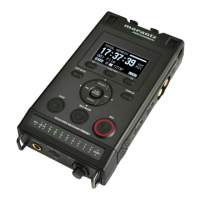53
State of pin *7) Category Pin name Name I/O Function Pin
count
(Pin nos.)
RST_N=”
L”
RST_N
goes “H”
PCUT=1
RST_N Reset signal IN At “L” level, the controller is initialized. 63 Input
(L)
Input
(H)
Input
(H)
System
control
TEST Test signal IN This should be fixed at “L” or open. 16
DP USB D+ data I/O This should be connected to the D+ pin of
the USB bus.
4 Input
(Hi-z)
Input
(Hi-z)
Input
(Hi-z)
USB bus
interface
DM USB D- data I/O This should be connected to the D- pin of
the USB bus.
3 Input
(Hi-z)
Input
(Hi-z)
Input
(Hi-z)
VBUS
monitor
input
VBUS VBUS input IN This should be connected directly to the
Vbus of the USB bus. The connected or
disconnected state of the Vbus can be
detected. If This pin is not connectted with
Vbus of a USB bus, connect it with 5V.
5 Input
(Hi-z)
Input
(Hi-z)
Input
(Hi-z)
Reference
resistance
REFRIN Reference input IN This should be connected to AFEA33G
through a 5.6 kΩ±1% resistance.
8
AFEA33V Transceiver unit
analog power
supply
- This should be connected to 3.3 V. 12
AFEA33G Transceiver unit
analog GND
9 -
AFED33V Transceiver unit
digital power
supply
- This should be connected to 3.3 V. 2
AFED33G Transceiver unit
digital GND
1 -
AFEA15V Transceiver unit
analog 1.5 V
power supply
- This should be connected to 1.5 V. 6
AFEA15G Transceiver unit
analog GND
7 -
AFED15V Transceiver unit
digital 1.5 V
power supply
- This should be connected to 1.5 V. 13
AFED15G Transceiver unit
digital GND
14 -
VDD Core power
supply
- This should be connected to 1.5 V. 40
VIF IO power supply - This should be connected to 3.3 V or 1.8
V.
15, 42,
64
Power
supply /
GND
41 - DNG latigiD DNGD
The “L” active and “H” active states of these pins can be specified using the control program for the user system
”_N” indicates that the “L” active state is the default state.
DSTB0_N and DACK1_N are assigned to the same pin, so the functions of one or the other are valid.
The input level of the MPBUS pin needs to be established just before the end of H/W reset. Also, this should no
be switched during operation.
When CS_N and RD_N are “L”, these pins output “H” or “L”.
If MPBUS is “H”, these pins can be made to open.
CS_N, WR0_N, and WR1_N should be kept as (a) or (b) during RST_N=”L” (from RST_N goes "L" to right afte
RST_N goes "H").
(a) CS_N=”H”
(b) WR0_N=”H” and WR1_N=”H”
Discription of “State of pin”
(a) Input : Pins are Hi-z state. Please do not make it “open” on a board.
(b) Input(Hi-z) : Pins are Hi-z state. Pins can be “open” on a board.
(c) H, L, H/L : Output states is shown.
These pins are in an inactive state.

